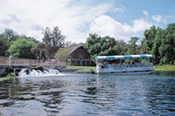
DeLeon Springs State Park is one of West Volusia's most beautiful attractions.
VOLUSIA COUNTY
Geographically, Volusia County sits 50 miles northeast of Orlando, between the St. Johns River and the Atlantic Ocean. But these days, in a region where the growth is pushing outward in all four directions, geography doesn’t mean as much as it once did.
Indeed, as metro Orlando spreads north and east along I-4 through Seminole County, Western Volusia is directly in growth’s path.
Today the area, once identified almost exclusively with Daytona Beach, is emerging as a suburb of Orlando. With nearly 70,000 residents, Deltona has long since surpassed Daytona Beach as the largest municipality in Volusia County. It has seen a 343 percent growth rate since 1980.
Much of the activity is spurred by commercial development along the so-called High-Tech Corridor, which runs the length of I-4 between Tampa and Daytona Beach. Projections call for the stretch of interstate between Lake Mary and Sanford, just east of the Volusia-Seminole border, eventually to contain more than 13 million square feet of office space.
The widening of the I-4-St. Johns River Bridge alleviated one of the region’s most annoying traffic bottlenecks, making western Volusia an easy 30-minute commute to downtown Orlando.
Lured by that surprising proximity, as well as by the region’s abundance of lakes, springs and the nearby beach, families have been flocking to the new home communities near I-4.
Buyers have also discovered the impressive stock of historic residences west of downtown DeLand, which is clearly one of the coolest small towns in Florida.
The quaint downtown district, which is on the National Registry of Historic Places, is thick with eateries and antique shops. And stately Stetson University, which has been located here for more than a century, adds an air of permanence.
Meanwhile, tiny Lake Helen, home to no stoplights or fast-food restaurants, is expected to grow 16 percent by 2025.
Those interested in more natural settings, plus an unusual lunch, may head north on U.S. 17 to DeLeon Springs State Park, where you can cook your own pancakes at the Old Spanish Sugar Mill and then paddle a canoe through the wilderness.
In the winter, manatees seeking warmer water can be seen lolling around at Blue Springs State Park. In the summer, humans, seeking relief from the heat, plunge into the same bubbling blue oasis.
NATURAL ATTRACTIONS
Outdoor recreation is a big part of life in West Volusia. County, state and national parks offer opportunities to enjoy nature, as well as culture, history and archaeology.
In the county as a whole, the Leisure Services Department manages more than 3,000 acres and operates some 50 recreation programs.
Here are a few West Volusia favorites:
Blue Spring State Park, Orange City. Manatees are the stars at this popular park. The endangered mammals are in residence between November and March, drawn by the spring’s constant 72-degree water. Humans can get a glimpse from the wheelchair-accessible platform. Camping, canoeing, diving and swimming are also allowed, though never with the manatees.
Gemini Springs Park, DeBary. Popular with families, this 210-acre park features a nature trail, a biking trail and picnic facilities. Some 6.5 million gallons of sparkling fresh water bubble out of its springs every day.
DeLeon Springs State Park, DeLeon Springs. This idyllic 603-acre oasis has been occupied off and on since 8000 BC. In addition to its own nature trail and wildlife-viewing opportunities, the park provides access to the Lake Woodruff National Wildlife Refuge. It’s also known for a more decadent attraction: the Old Spanish Sugar Mill and Griddle House. Set near the remains of an old sugar mill, the restaurant’s specialty is make-your-own pancakes from flour stone-ground on the site.
Hontoon Island State Park, Deland. This is the place to go for fishing, hiking, boating, canoeing and camping. An 80-foot observation tower gives visitors a bird’s-eye view of scenic Florida. The three-mile-round-trip trail starts at the ranger station and passes a large shell mound that’s a relic of the original inhabitants, the Timucuans.
Other popular natural attractions include Lake Monroe and Ed Stone parks, which provide boat access to the St. Johns River.
Park-goers can fish for bass or catch a glimpse of bald eagles, alligators, osprey and otters in the Wild Andyonia Preserve, a classic scrub habitat behind the library in Deltona.
It’s one of the best places to see the Florida scrub jay, a protected species. The birds are so friendly and inquisitive, they’ll perch on your shoulder and accompany you down the path.
Additional information can be found at www.volusia.org/parks. —G. K. Sharman
